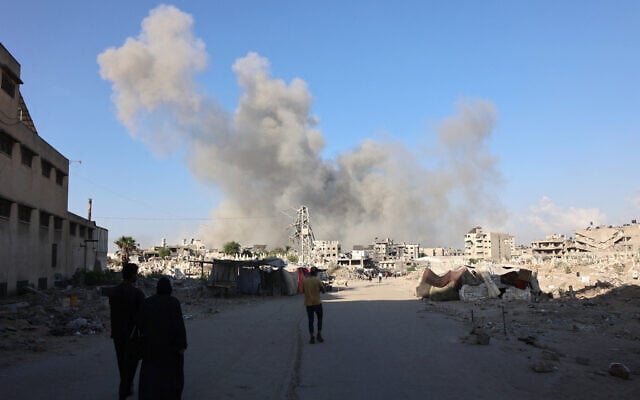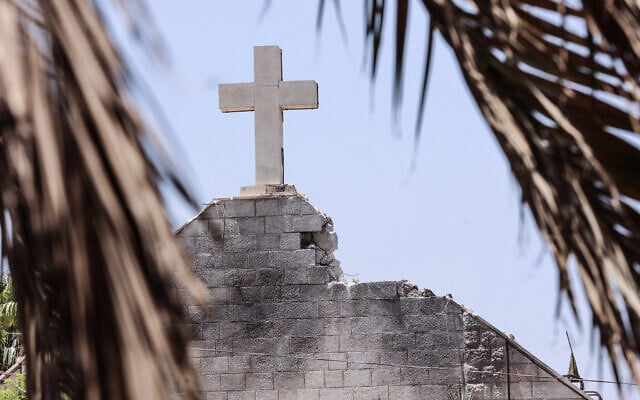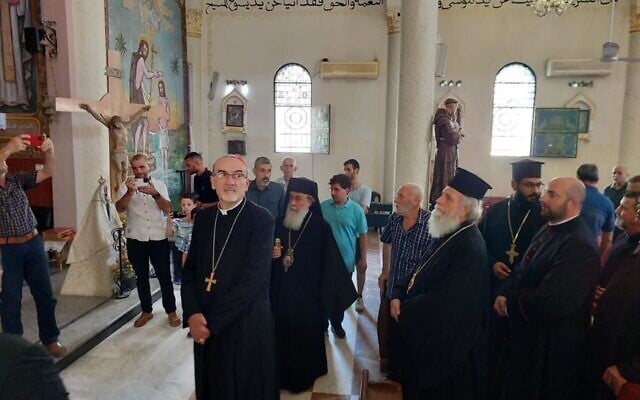More Palestinian families left Gaza City on Tuesday after reporting a night of Israeli shelling on its outskirts, as the military geared up for its new offensive to conquer the area.
Residents said Israeli aerial and tank shelling continued throughout the night and early on Tuesday in the eastern Gaza City suburbs of Sabra, Shejaiya, and Tuffah, as well as in Jabalia to the north, destroying roads and houses.
“Earthquakes, we call it. They want to scare people to leave their homes,” said Ismail, 40, a Gaza City resident.
At least 34 people were killed in Israeli strikes in the enclave overnight and on Tuesday, Hamas-run local health authorities said, including 18 people around Gaza City. The figures are not independently verified, and do not distinguish between combatants and civilians.
The Israel Defense Forces has said it is operating in the area to locate weapons and destroy tunnels used by terrorists. The security cabinet was scheduled to discuss Gaza and efforts to reach a hostage deal on Tuesday afternoon, the Prime Minister’s Office told The Times of Israel, as nationwide protests called for a comprehensive deal to end the war and secure the release of all the hostages abducted by terrorists during the Hamas-led October 7, 2023, massacre that sparked the conflict.
The plans to conquer Gaza City have drawn fierce opposition from hostages’ families who fear the planned operation will risk the lives of their loved ones, as well as international outcry, with governments and humanitarian groups warning of potentially disastrous consequences for Gaza’s civilians, noting widespread malnutrition that has recently worsened significantly.

On Monday, UN spokesperson Stéphane Dujarric said during a briefing that 11 more people died from malnutrition and starvation in the preceding 24 hours, bringing the total figure since the start of the Gaza war to 300, according to Hamas-run Gaza health ministry figures.
Updating reporters on developments in Gaza, Dujarric said roughly 5,000 people have been displaced from northern Gaza to Deir al-Balah in the central Strip and Khan Younis in the South since August 20. He added that some 8,000 others have been displaced to the west of Gaza City, bringing the total number of new displacements since the end of the ceasefire in mid-March to more than 800,000.
Moreover, UN partners have reported that several education facilities, which are also used as shelters, were attacked last week, Dujarric said.
Dujarric claimed that Israeli authorities continue to inhibit the delivery of humanitarian aid throughout Gaza, denying or impeding eight of 15 UN missions to transport assistance over the past 24 hours.
Israel has dismissed reports of starvation in Gaza as Hamas propaganda, but instituted a series of measures to alleviate hunger in the Strip in July following international pressure, including airdrops and 10-hour “humanitarian pauses” in military operations in three population centers to allow deliveries of aid.
Earlier in August, for the first time in nearly a year, Israel announced it would allow the entry of goods into Gaza through the private sector, an effort aimed at increasing the flow of essential food and hygiene items that were previously only delivered by aid organizations.
The US- and Israel-backed Gaza Humanitarian Foundation (GHF), established to provide aid via an alternative that would keep goods out of Hamas’s hands, has been plagued by near-daily shooting incidents, in which the UN has said more than 1,000 people were killed as they tried to reach GHF distribution centers, allegedly by IDF gunfire.
Meanwhile, clergy and nuns from the Greek Orthodox and Catholic churches in Gaza City have decided that they will not evacuate ahead of the upcoming offensive, and will instead remain within the church compounds to provide care for those unable to flee.

In a joint statement Tuesday, the Greek Orthodox Patriarchate and the Latin Patriarchate of Jerusalem said that the Greek Orthodox compound of Saint Porphyrius and the Holy Family Church compound “have been a refuge for hundreds of civilians” since the outbreak of war in October 2023, among them “elderly people, women, and children,” as well as disabled Gazans.
“Like other residents of Gaza City, the refugees living in the facilities will have to decide according to their conscience what they will do,” they said.
“Among those who have sought shelter within the walls of the compounds, many are weakened and malnourished due to the hardships of the last months. Leaving Gaza City and trying to flee to the south would be nothing less than a death sentence.”
The patriarchates said that “for this reason, the clergy and nuns have decided to remain and continue to care for all those who will be in the compounds. ”
“We do not know exactly what will happen on the ground, not only for our community, but for the entire population,” they acknowledged. “We can only repeat what we have already said: There can be no future based on captivity, displacement of Palestinians, or revenge.”
“This is not the right way,” they said, calling for both an end to the “senseless and destructive war” and for the return of the hostages being held by Gazan terror groups. “It is now time for the healing of the long-suffering families on all sides.”
In July, three people were killed and several were injured in an IDF strike on the Holy Family Church compound. The military later said that a misfired munition was to blame.
In the aftermath of the strike, which prompted widespread international outrage, Latin Patriarch of Jerusalem Cardinal Pierbattista Pizzaballa and Orthodox Patriarch Theophilus III entered the Gaza Strip to survey the damage and meet with members of the enclave’s Christian minority.

Meanwhile, the IDF released new footage showing the destruction of two Hamas tunnels in the central Gaza Strip, part of a monthlong operation by forces from the Gaza Division’s southern brigade, the elite Yahalom combat engineering unit, and the Gaza Division’s engineering units.
According to the military, one of the tunnels, which featured multiple exit shafts, contained living quarters, food, weapons, and other facilities used by Hamas operatives. Troops sealed the tunnel by filling it with concrete. A second offensive underground route, stretching hundreds of meters, was destroyed with explosives.
The IDF said that in the course of the operation, dozens of Hamas fighters were killed, and both underground and aboveground terror infrastructure was dismantled. The military added that the effort was aimed at widening the security buffer along the central and southern border of the Gaza Strip.
The ongoing war erupted when Hamas-led terrorists led a massacre of southern Israel on October 7, 2023, killing 1,200 people, mostly civilians, and taking 251 hostages to Gaza.
The Hamas-run Gaza health ministry says more than 62,000 people in the Strip have been killed or are presumed dead in the fighting so far, though the toll cannot be verified and does not differentiate between civilians and fighters. Israel says it has killed over 22,000 combatants in battle as of August and another 1,600 terrorists inside Israel during the October 7 onslaught.
Israel has said it seeks to minimize civilian fatalities and stresses that Hamas uses Gaza’s civilians as human shields, fighting from civilian areas including homes, hospitals, schools, and mosques.
Israel’s toll in the ground offensive against Hamas in Gaza and in military operations along the border with the Strip stands at 460.

